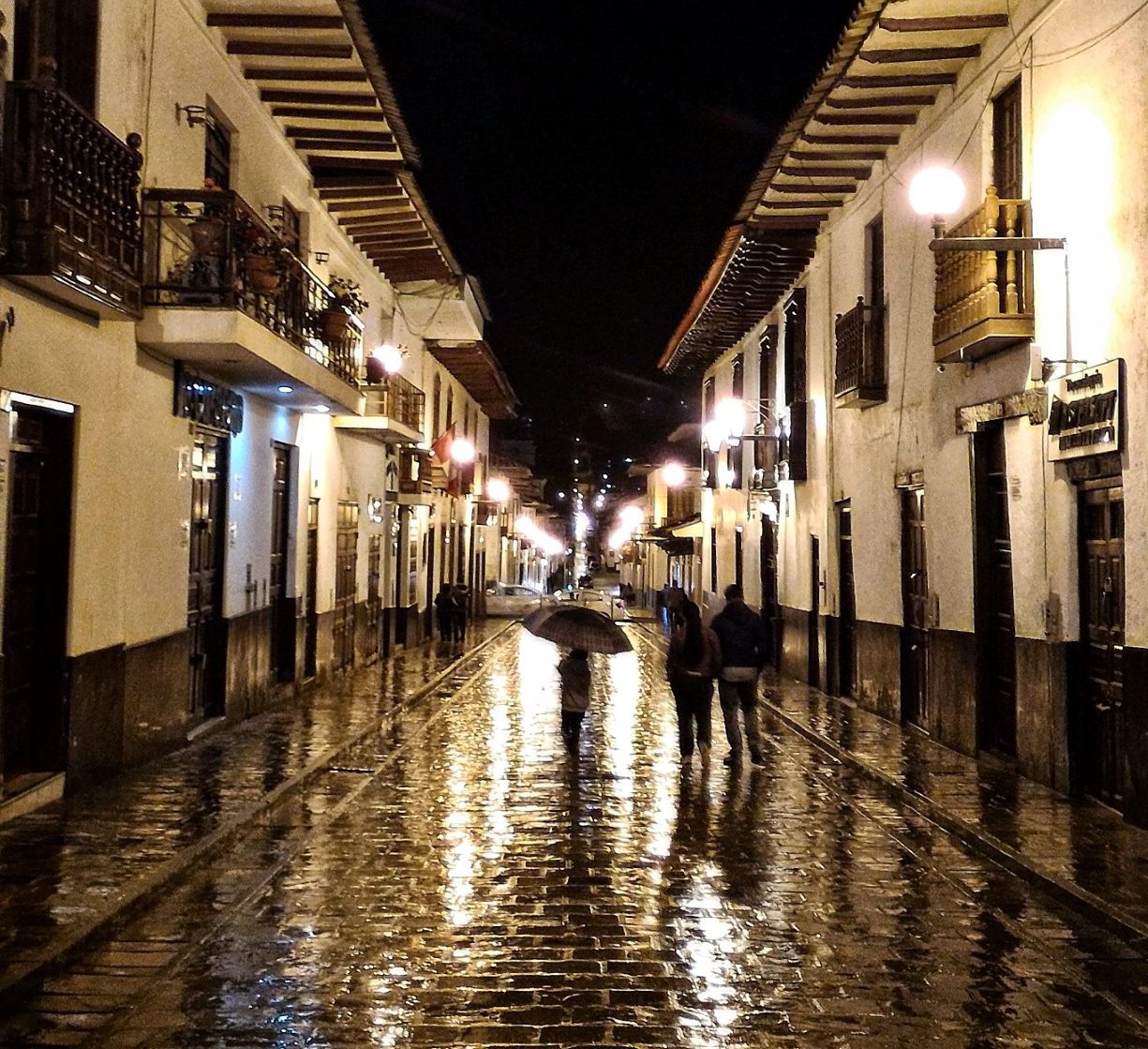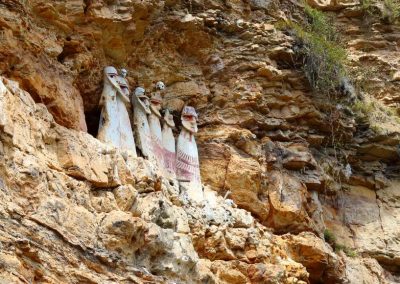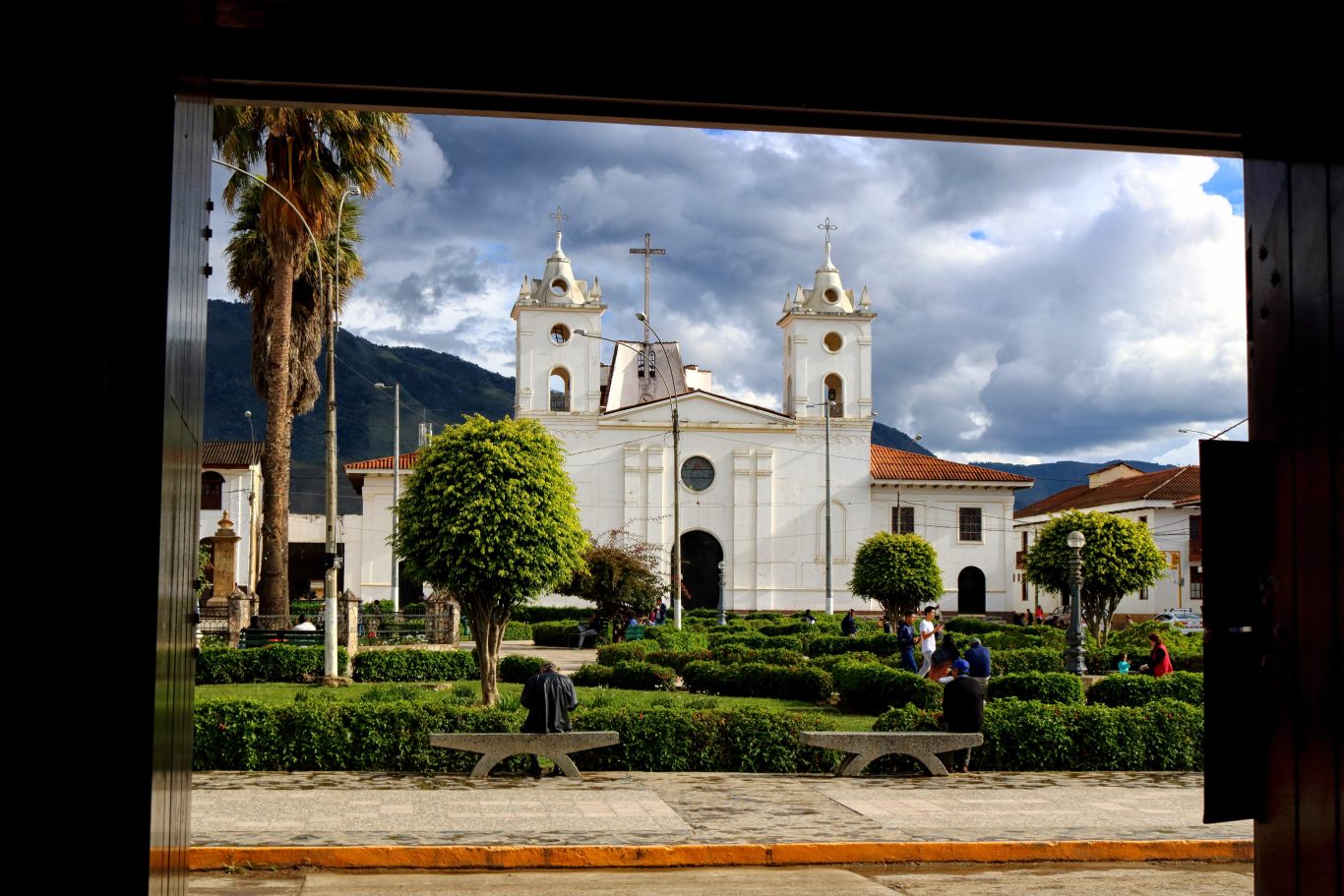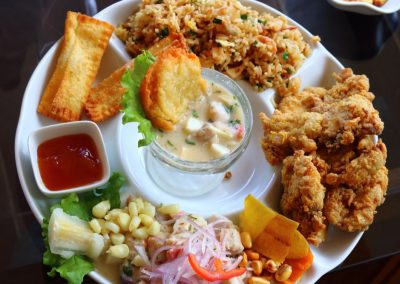The pedestrian-only Jr. Amazonas, which begins at the Plaza de Armas of Chachapoyas and stretches for five blocks. Photo by Tony Dunnell.
Sat on the eastern slopes of the Andean range at some 2,335 meters above sea level, Chachapoyas has long been accustomed to its own isolation. Founded in 1538, just three years after Francisco Pizarro founded Lima, the secluded city has developed its own particular style: Undeniably of the sierra but touched by the selva; of both the Peruvian highlands and the jungles to the east.
Despite its relative remoteness, today Chachapoyas is stirring. The sleeping city is awakening to embrace a bright new future; its picturesque colonial streets have a certain buzz, their wooden balconies looking down on a steadily growing influx of domestic and international tourists.
This new wave of tourism has been stimulated by investment into the Chachapoya archaeological site of Kuélap and its shiny new cable car system. At the same time, new air routes are making it easier than ever before to reach Chachapoyas from the capital. And the city — with its polite and helpful inhabitants (pop. 30,000), comfortable hotels, affordable food and strangely ubiquitous taxis — seems more than ready to receive a new wave of visitors.
But before you go, know this: Chachapoyas has plenty more to offer beyond the two nationally-renowned sites of Kuélap and Gocta Waterfall. Many more archaeological sites and natural attractions dot the Amazonas region, of which Chachapoyas is the capital, and opportunities for outdoor adventure are finding a firm foothold.
New trekking, rafting and canyoning initiatives are being developed by young outdoor enthusiasts, and it would come as no surprise to me if, in another few years, Chachapoyas develops a reputation as much for its outdoor adventure activities as for its big-name attractions.
Now if only they could sort out their internet…
All photos in this Chachapoyas travel guide are by Tony Dunnell and © New Peruvian.
Things to Do in Chachapoyas and the Surrounding Area
Chachapoyas is an attractive city with photogenic streets and a pretty Plaza de Armas. And while you won’t find any must-see attractions within Chachapoyas itself, the surrounding area is full of memorable day trips to archaeological sites, natural wonders and cultural centers, most within a two-hour bus ride.
Attractions in Chachapoyas:
- Plaza de Armas — Perfect for people watching, Chachapoyas’ main square is a fine place to relax and watch the world go by. It’s also surrounded by tour agencies, restaurants, hotels and the ever-useful mini mercado (mini-market).
- Pozo de Yana Yacu (Yana Yacu Well) — This historic well is located half way up the steps leading to the Luya Urco mirador (see below). Legend has it that Saint Toribio Alfonso de Mogrovejo, then the Archbishop of Lima, came to Chachapoyas while the settlement was suffering a severe drought. He hit his staff three times on the rocks, and water began to spout from the ground. A well was built around the new water source, quenching the first of the local inhabitants. It’s also said that single people who drink from the well will remain in Chachapoyas forever, enchanted by the beauty of the local women. The local ladies need not fear, however, as the well is covered and completely dry. Yana Yacu isn’t a must-see by any stretch of the imagination, but you’ll pass it as you walk up to…..
- Luya Urco Mirador (Luya Urco Viewpoint) — Head up past the well and take a right at the top of the steps and you’ll come to Luya Urco Mirador, which offers a good view of Chachapoyas below.
- Museo Étnico Religioso e Histórico de Santa Ana (Santa Ana Ethnic Religious and Historical Museum) — A tiny museum that’s not really worth visiting unless you’re really bored or have a fetish for gaudy religious robes. The highlight of the tiny collection is a scale model of Kuélap.
- Gilberto Tenorio Ruíz Exhibition Room — This exhibition room on the Plaza de Armas is now home to the permanent “El Reino de las Nubes – Las Chachapoyas” museum. I didn’t visit because it shut for the weekend and I ran out of time in Chachapoyas, but I imagine it’s a better option than the Santa Ana Museum. And it has mummies.
- Chachapoyas Market — I really like this market. It’s colorful, has a wide range of fruits, meats, cheeses and other regional produce, and is full of good photo opportunities. The food stalls on the second floor also offer cheap eats, including tasty causa rellena for just S/ 4 (weekends only, I think). The ceviche looks sketchy, so you might want to avoid it unless you have guts of steel.
- Pampa de Higos Urco — Just east of the city and across from Chachapoyas’ large university is the pampa de Higos Urco, a hilltop that marked the main center of the Battle of Higos Urco, fought between pro-independence and pro-Spanish forces on June 6, 1821. A simple graffiti-scarred monument marks the victory for independence. Worth visiting if you fancy a stroll after eating at Los Guayachos Restaurant (see restaurants section below).
A stall owner inside Chachapoyas Market. Photo by Tony Dunnell.
Attractions outside Chachapoyas (day trips):
Chachapoyas is the main base for exploring the most famous attractions in the Amazonas region. Kuelap and Gocta are the two classic sights, but there’s plenty more to discover.
- Kuélap — The archaeological site of Kuélap is the poster boy for the promotion of northern Peru. The new cable car system running up to the site is the first to be built in the entire country, and has helped generate plenty of additional buzz around the walled Chachapoyas settlement/fortress/citadel. Kuélap is frequently referred to as the “Machu Picchu of Northern Peru,” which doesn’t necessarily do it any favors. It’s impressive, there’s no doubt about that, but Machu Picchu is a whole different level of spectacular. You can get to Kuélap by tours and independently.
- Catarata de Gocta (Gocta Waterfall) — Depending on the criteria used, Gocta is anywhere between the fourth- and 16th-tallest waterfall in the world. Ranking aside, Gocta is a beautiful, powerful and impressive waterfall, and justifiably one of the main attractions in Amazonas. It’s easy to reach via a two-hour trek from the village of Cocachimba (you can hire a horse if you don’t like trekking). You do not need to sign up for a tour to reach Gocta Waterfall, as it’s easy enough to get there independently.
- Sarcophagi of Karajía — Another emblematic archaeological site of the Amazonas Region, the sarcophagi of Karajía sit in a cliff-face nook overlooking a steep-sided valley below. If, like me, you enjoy history and archaeology, then it’s certainly worth visiting Karajía as a day-trip from Chachapoyas (tours combine Karajía with a visit to Quiocta Cavern; see below). If not, then you might find it an underwhelming experience considering the length of time required (a full day, basically).
- Caverna de Quiocta (Quiocta Cavern) — Most tours head to the Caverna de Quiocta after visiting Karajía. I didn’t get to see the cavern as a member of my group had an accident after Karajía (note: never open an umbrella while sitting on an unprepared horse), forcing us to return to Chachapoyas. Talking to other tourists, Quiocta sounds like a fairly minor attraction (some told me it was OK, others said it was dull). If you’ve been to caves elsewhere in the world, then you might want to skip Quiocta.
- Huancas and the Miradors of Sonche and Huanca Urco — Head out to the village of Huancas, about 15 minutes from Chachapoyas, for spectacular views of the Sonche and Huanca Urco canyons. The Sonche mirador (viewpoint) is the most popular, but the mirador at Huanca Urco offers perhaps even more impressive views. If you want to do some independent trekking, you’ll find trails leading away from each mirador. In theory, you should be able to hike from one mirador to the other along the rim of the canyons, but the trail is tricky to follow, so prepare to get lost and possibly retrace your steps (we tried twice and failed to complete the whole trail).
- Levanto — Levanto is a colonial town a few miles south of Chachapoyas. Levanto and the wider Levanto District are home to a number of archaeological sites, including remains of the Qhapaq Ñan (Inca road system), the Yalape settlement, and Yurac Urco at Collacruz.
- Mendoza — The town of Mendoza, capital of the Rodríguez de Mendoza Province of Amazonas, is about 30 miles east-southeast of Chachapoyas (as the crow flies). Known for its good climate and fertile soils, Mendoza is one of the main coffee growing regions in Amazonas. Tourist attractions near Mendoza include Huamanpata Lake (best to visit between February and July) and the Aguas Termales de Tocuya (thermal waters). According to a friend of mine in Chachapoyas, the thermal baths aren’t actually hot, which is a big disappointment if you drive two and a half hours from Chachapoyas for a nice warm soak.
- Leymebamba and Leymebamba Museum — Leymebamba (sometimes Leimebamba) is a pretty town south of Chachapoyas, reachable by local minibus in just under two hours. The main attraction is Leymebamba Museum, which houses hundreds of Chachapoya mummies from Laguna de los Cóndores. Some are eerily well-preserved, enough to send a few shivers down susceptible spines. You don’t need a tour to visit Leymebamba, unless you want to combine the museum with a trip to Revash (below), a day-trip combo offered by most tour agencies in Chachapoyas.
- Revash — Revash is a Chachapoya funerary complex south of Chachapoyas, roughly en route to Leymebamba. Unlike the sarcophagi at Karajía, the mausoleums at Revash are like little houses, forming miniature villages along the canyon wall.
The beautiful Huaylla Belén river valley. Photo by Tony Dunnell.
Outdoor Activities in Chachapoyas
Outdoor enthusiasts will get a real kick out of Chachapoyas. Adventure sports are still in development, but the future possibilities are promising indeed. For me, the chance to trek, raft and go canyoning (and fishing) really made Chachapoyas shine as a fully-fledged tourist destination in Peru — and one likely to go from strength to strength in the next few years.
- Trekking — Trekking opportunities abound in the Amazonas Region, and Chachapoyas serves as a great base. The walk to Gocta is an easy day hike from Cocachimba, or you can head a little further north to Cuispes and hike well-marked trails along a beautiful waterfall circuit that includes the towering Yumbilla Falls. For multiday treks, consider the Gran Vilaya circuit or the trek (or horse ride) out to Laguna de los Cóndores.
- Canyoning (Barranquismo) — This is a new initiative set up by a friendly and ever-enthusiastic Spaniard named Juan Luis Molins Perez and his Canyoning Explorer agency. Canyoning (canyoneering) is an outdoor activity that mixes various techniques — including rappelling (abseiling), walking, scrambling, jumping and swimming — to traverse through and down canyons. With Canyoning Explorer you’ll head to Cuispes and the waterfall circuit, where various canyoning routes are being developed ranging in difficulty from total beginner to professional. Highly recommended!
- Rafting (Canotaje) — Another start-up in the local outdoor activities scene, Chacha Rafting (www.chacharafting.com) offers fun rafting trips down the Utcubamba River. Whitewater levels range from II to potentially IV. Chacha Rafting is currently operating out of the Amazon Expedition tour agency office on the Plaza de Armas. Rafting starts at S/ 80 per person.
- Huaylla Belén — This astoundingly pretty valley offers a bit of everything for outdoor fanatics. You can spend the day trekking, or set up camp and just enjoy the scenery; you can splash around in the winding river, or maybe even arrange a day of fly fishing. Fly fishing isn’t currently offered by any of the agencies in Chachapoyas; if you’d like to fly fish, contact me for more information (I have a friend in Chachapoyas who might be able to help). Few, if any, local agencies offer trips to Huaylla Belén, so you’ll probably need to sort out private transport.
Tour Agencies in Chachapoyas (and Sample Prices)
You’ll see quite a few tour agencies dotted around Chachapoyas, most of which offer the same tours.
- Chachapoyas Expedition (Ortiz Arrieta 530, Plaza de Armas; www.chachapoyasexpedition.com) — I went to Kuélap with Chachapoyas Expeditions and it all went well. The guide had some New Age-ish ideas about the significance of Kuélap, some of which were too “out there” for me, but it was an excellent trip overall.
- Amazon Expedition (Ortiz Arrieta 508, Plaza de Armas; amazonexpedition.com.pe) — Another good agency. Go here to arrange both standard tours and rafting trips.
- Turismo Explorer (Grau 549, Plaza de Armas; turismoexplorerperu.com) — I went to Karajía with these guys and the trip was cut short when a female member of the group fell off her horse. The agency coped with the situation fairly well, although should have been more forthcoming with at least a partial refund. Apart from that, Turismo Explorer seems like a good option.
- Hostal Revash (Grau 517, Plaza de Armas) — This long-established hotel also offers tours, including Gran Valaya treks. If you need information, ask to talk to Fernando Burga, a highly knowledgeable local and former guide who works at the hotel.
- To arrange treks to Laguna de los Cóndores (bypassing the agencies), try calling one of the following guides in Leymebamba: Eyrin (941 850 671) or Sinecio (957 471 938).
Approximate all-included prices (entrance fee, lunch, transport and guide) for the standard tours are:
- Kuelap — S/ 100
- Gocta — S/ 60
- Leymebamba Museum and Revash — S/ 125
- Karajía and Quiocta — S/ 95
Chachapoyas Cathedral and Plaza de Armas. Photo by Tony Dunnell.
Hostels and Hotels in Chachapoyas
Chachapoyas has a good range of hostels and hotels at affordable prices. Even the upper scale accommodation options are reasonably priced, and are generally cheaper than in Peru’s major cities. Unlikely almost everywhere in Peru, most hotels and hostels in Chachapoyas don’t offer a free breakfast.
I’ve stayed at all of the hostels and hotels mentioned below, unless otherwise stated; they are ordered (roughly) from the cheapest to the most expensive. Many use Booking.com for reservations, so you can check current room rates there (prices listed below are subject to change).
- Aventura Backpackers Lodge (Amazonas 1416; facebook.com/AventuraBackpackersLodge) — Probably the cheapest option in town, with dorms starting at S/ 15. I didn’t stay at Aventura, but I did pop in for a look and it seems like a good place. The hostel is four and a half blocks from the main square, which is further out than most, but still not far at all.
- Chachapoyas Backpackers (Dos de Mayo Street 639; www.chachapoyasbackpackers.com) — This is a great place with friendly staff, a good kitchen, clean rooms and a perfect location just a block and a half from the Plaza de Armas. It also seems to be a good spot for meeting other travelers. A single room with shared bathroom starts at around S/ 40; dorm beds are around S/ 26. Book here.
- Hostal Revash (Grau 517) — This is one of the oldest hotels in Chachapoyas. Some of the rooms are a little antiquated, which you’ll either find charming or not. I like it, and the leafy courtyard and knowledgeable staff (especially Fernando) give the whole place a great vibe. It’s also smack bang on the Plaza de Armas. Rates are anywhere between S/ 35 and S/ 70 per person, based on two-person occupancy. The more expensive rooms have a view of the plaza and a small balcony. Book here.
- Las Orquideas (Ayacucho 1231; www.hostallasorquideas.com) — Modern, spotlessly clean and with great bathrooms, Las Orquideas is a good option for groups and families thanks to the availability of large rooms with up to five beds. Comfortable matrimonial rooms are also available. The owner, Señor Jorge, is friendly and attentive. Book here.
- Hotel Posada del Arriero (Grau 636; www.posadadelarriero.net) — Another spotlessly clean hotel in Chachapoyas, Posada del Arriero is a modern colonial-style building with three floors of rooms surrounding a central courtyard. Book here.
- Ñuñurco Travellers Hotel (Ortiz Arrieta 186) — Clean, friendly and with spacious communal areas, it’s easy to feel at home in Ñuñurco. The owners and staff always greet you with a smile and are on hand with plenty of information. A single room with private bathroom is S/ 60; doubles and matrimonial rooms are S/ 80; and triples for S/ 110. Book here.
- La Casona de Chachapoyas (Chincha Alta 569; lacasonadechachapoyasperu.com) — La Casona de Chachapoyas is situated in an elegant colonial building surrounding a charming courtyard that wouldn’t be at all out of place in Cusco (but where you’d be paying four times as much). This was my favorite hotel in Chachapoyas, but also the most expensive. Breakfast is included, and it’s definitely worth getting up for. Book here.
- Gocta Lodge (goctalodge.com) — This is the most famous lodge out near Gocta Waterfall. And it’s a great place: bright, comfortable, relaxed, friendly, excellent food (breakfast included), good bar, and a swimming pool with a view of Gocta. Gocta Lodge is easily one of my top 10 hotels in Peru, possibly top three. Rooms range from S/ 259 to S/ 419 for a suite.
Cafés and Restaurants in Chachapoyas
You can eat well in Chachapoyas, and even the most upscale restaurants are surprisingly affordable by Peruvian standards. You’ll also find plenty of cafés selling local coffee and tempting cakes.
- Cafés in Chachapoyas — You’ll never be far from a cozy café for your daily dose of coffee. Keep an eye out for cafés and coffee shops bearing the Ruta del Café logo, which guarantees fresh coffee from the Amazonas region. These include Café Fusiones (more on this below), Alejandra Chocolateria (great chocolates, cakes, cheesecake and more; facebook.com/ChocolateriAlejandra), Cal Payes (facebook.com/calpayes) and Café Karajía (facebook.com/karajiacafe).
- Café Fusiones (Ayacucho 952, Plaza de Armas; cafefusiones.com) — Café Fusiones deserves its own mention for various reasons. Firstly, it’s a gathering place for all kinds of tourists, expats and wayward wanderers. It also serves a great breakfast, organic coffees, craft beers and a fantastic hot chocolate with rum (one of my weaknesses). The setting is colorful, artsy, warm and relaxing. If the Wi-Fi was faster and more reliable, Fusiones would be near-perfect.
- Raymistura (Ayacucho 1013) — Located just half a block from the main square, this restaurant serves a cheap and tasty lunchtime menú for between S/ 6 and S/ 10. You can choose from a range of traditional Peruvian comida criolla dishes and chifa options.
- El Tizón (Ortiz Arrieta 516, Plaza de Armas) — Don’t let the dark interior put you off, as El Tizón serves a good menú for about S/ 8 and surprisingly good chicken dishes (pollo a la brasa, chicharrón de pollo etc.) at night. Nothing fancy, but hits the spot when you’re hungry.
- La Tushpa (Ortiz Arrieta 753) — Meat-eaters might want to check out La Tushpa, which serves steaks and other chunks of meat. Not out-of-this-world, but good for the price.
- Sabores de Peru (Dos de Mayo 321) — Sabores de Peru’s friendly owner is passionate about her food, and the house specialties are versions of traditional homemade cooking from her childhood. The restaurant was empty when I went and the atmosphere was lacking, but if you want to try traditional food like ucho de papas (potatoes mixed with cecina and chorizo), cuy in walnut sauce, or trout chaufa, then Sabores is worth a shot. Order a hot draque to drink on a cold night.
- MILU Cocina Fusión (Puno 240) — MILU is a fancy chifa serving good Peruvian-Cantonese dishes. Most plates are in the S/ 20 to S/ 30 range, with a cheaper chifa menú for lunch (around S/ 10 to S/ 15).
- Candela (Dos de Mayo 728; facebook.com/Candela-800390693340236) — Pizza in Peru is normally overpriced and average (at best). Candela probably has the best pizza in Chachapoyas, and while it’s not cheap (S/ 24 to S/ 32 for a pizza for one, which is pricey by Chacha standards), it certainly ticks most — if not all — of the boxes when it comes to pizza.
- Los Guayachos Restaurant (Higos Urco 169; losguayachos.com) — Los Guayachos is a short taxi ride outside of town, up by the university and Pampa de Higos Urco, and it’s well worth a visit for grilled meat dishes and Peruvian classics. I had the costillas ahumadas en reducción de chila (smoked ribs in a chila sauce; S/ 27) and they were amazing — some of the best ribs I’ve had in Peru.
- Mistura Urco (Puno 325) — Along with Los Guayachos and El Batán del Tayta, Mistura Urco is without doubt one of the best restaurants in Chachapoyas. Foreign tourists, however, don’t seem to know about it. Mistura Urco specializes in seafood, but also has an extensive range of local and national classics. If you’re hungry, order a S/ 30 seafood and ceviche combo, which will keep you full and feliz all day long. Thanks to its relaxed atmosphere, low tables and comfy seats, Mistura Urco is the perfect place for a long and lazy lunch. Not to be rushed.
- El Batán del Tayta (La Merced 604; facebook.com/ElBatanDelTayta) — This is Chachapoyas’ flagship restaurant, known as much for its great food as for the whimsical presentation. I’ll be writing a standalone article about the restaurant in the future. For now I’ll just say this: don’t leave town without eating at El Batán.
Nightlife in Chachapoyas
Chachapoyas is almost devoid of nightlife, so you won’t find it too hard to wake up for all those 8 a.m. tours. But when you fancy a beer — or something stronger — you’ll at least have a handful of bars to choose from, and booze is normally cheap in Chacha, too.
- La Reina (Ayacucho 544) — This is the place to go drinking in Chachapoyas (not that it has much competition). La Reina is an elegant and spacious drinking spot surrounding a colonial-style courtyard with wooden balconies and plenty of plants. The clientele is mixed and can include businessmen, students, friendly drunks and tourists on any given night. La Reina is known for its aguardiente infusions, which include everything from maracuya to milk to siete raices (a classic jungle infusion). If you want to try them all, order the 12-glass arco iris — ideally with two or three friends.
- Other bars — No offence to all the “other bars” in Chacha, but none of them rival La Reina. You’ll see a handful dotted around, but none stand out. I went into Bar Silvia’s for a few beers, which is a good spot for no-frills drinking and has saloon-style swinging doors to keep all you cowboys happy.
- Organik (Santa Ana 199, about eight blocks from the Plaza de Armas) — This is the main discoteca in Chachapoyas (there are only two), and it’s a decent place for late-night drinks and drunken dancing. It’s fairly big and spread over two floors. The music is standard Peruvian stuff. Entrance is S/ 7 at the weekend.
Getting to and Around Chachapoyas
Chachapoyas used to be one of the most isolated cities in Peru, with no regular scheduled flights in or out and limited road connections. But with all the investment in Kuélap, the Peruvian government had to make sure people could actually get to Chachapoyas without spending a day on a bus.
Chachapoyas is also a popular stopover for people coming from or going to Ecuador via the San Ignacio border crossing point (an alternative to the more hectic coastal border crossing up near Tumbes). You can get to San Ignacio from Chachapoyas along the road that passes through Bagua and Jaén.
Flights to Chachapoyas:
There are now three air options to consider for getting to Chachapoyas. You can fly from Lima to Chachapoyas with ATSA (www.atsaairlines.com) twice a week (Monday and Thursday), with one-way tickets starting at around $65.
Alternatively, you can fly from Lima to Tarapoto and then to Chachapoyas. From Tarapoto, SAETA (www.saetaperu.com) has three flights daily to Chachapoyas for as little as S/ 70 for Peruvians and other legal residents. Foreigners, however, have to pay S/ 220. Still, the flight takes just 25 minutes, compared with seven or eight hours by bus.
Or you can fly with LATAM to Jaén. Jaén is about 75 miles northwest of Chachapoyas, and around three hours by bus depending on road conditions.
Flights from Lima and Tarapoto to Chachapoyas are susceptible to delays and cancellations, especially during the rainy season from December to April.
Buses to Chachapoyas:
If you’d rather take the bus, two of Peru’s major bus companies, Movil Tours and Civa, both have buses direct from Lima to Chachapoyas (22 to 24 hours, tickets around S/ 120). Or you can head to Chachapoyas from other coastal cities like Trujillo and Chiclayo.
Regular overland connections also run from Tarapoto to Chachapoyas (about eight hours) via Moyobamba and Pedro Ruiz. The road between Chachapoyas and Cajamarca is also now open, and takes about 10 hours (conditions permitting).
Getting around in Chachapoyas:
Due to its small size, Chachapoyas is easy to explore on foot, although navigating can be a little confusing for the first few days as many of the central streets look the same.
If you need to head all the way across town, then you’ll have plenty of surprisingly modern white taxis to choose from (you can get to most places in or just outside the town for three or four soles). Mototaxis are banned from Chachapoyas, which helps keep the city nice and quiet.
If you want to head further afield independently rather than with a tour, head to the Terminal Terrestre de Chachapoyas, the main bus terminal. From here, combis and colectivos (minibuses) head to most of the surrounding towns, including Nuevo Tingo (for Kuélap), Cocahuaico (for Cocachimba and Gocta), Leymebamba, Mendoza and more.
Safety in Chachapoyas
Chachapoyas seems like one of the safest places I’ve been to in Peru. That’s partly due to its small size, but also thanks to a sense of community spirit and mutual respect among the Chachapoyanos. Walking around the city center at night is very relaxed, but solo female travelers should always be a little careful walking through deserted streets after dark.
The police presence in and around Chachapoyas also seems unusually high for a city of this size. Police road checks are common outside the city, in which cars and buses are pulled over and all passengers are asked to show their ID cards. Foreign tourists are normally ignored, but it’s worth carrying a photocopy of your passport just in case you’re asked for identification.
Withdrawing and Exchanging Money in Chachapoyas
There are only a handful of ATMs in Chachapoyas (about four total, as far as I’m aware). Some of them run out of money, so it’s worth arriving in Chachapoyas with enough cash to at least get through your first day and night. You can read more about ATMs in Peru here.
There are no street money changers in Chachapoyas, so your best option for changing money is inside the Banco de la Nación on the corner of Ayacucho and Dos de Mayo, a block from the Plaza de Armas. If you’re using US dollars in Peru and need to exchange them for soles, make sure the notes are in near-perfect condition or the bank won’t accept them.
I was also told that there’s a casa de cambio (bureau de change) somewhere in town, but I never found it.
Internet in Chachapoyas
The internet in Chachapoyas is worse than in Iquitos, and that’s pretty damn bad. Some hotels have satellite internet, which is bearable as long as the weather is good. Otherwise, the Wi-Fi in hotels, restaurants and cafes is often too slow to use (or too slow to even connect).
I imagine one-day Chachapoyas will receive an upgrade to bring it up to speed with internet access across Peru, but for now it’s sadly lacking.
Weather in Chachapoyas
Chachapoyas has a temperate climate with a fair amount of rain. The rainy season tends to run from the end of October to April, with May to September being the driest months (and therefore optimal for most tours and outdoor activities).
Major Festivals and Events in Chachapoyas
- Semana Santa (Holy Week) — movable feast, March/April.
- Raymillacta — a major folkloric festival, typically held during the first week of June, and combining with Chachapoyas’ Semana Turística (Tourist Week).
- Fiesta de la Virgen Asunta — a religious and cultural celebration on August 15.
Help Expand This Chachapoyas Travel Guide
If you have additional information or extra recommendations to help expand and improve this Chachapoyas travel guide, then don’t hesitate to leave a comment below. All opinions and points of view are more than welcome. Thanks!


















Trackbacks/Pingbacks